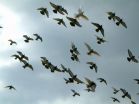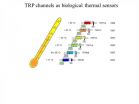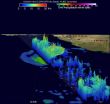(Press-News.org) Having a hierarchical social structure with just a few well-connected leaders enables pigeon flocks to navigate more accurately on the wing, new research shows.
Hierarchical organisation also enables flocks to cope better with navigation errors made by individual birds.
Researchers from Oxford University and the Zoological Society of London created 'virtual flocks' of homing pigeons to test how different social networks affect the navigation performance of these groups. The team's simulations looked at everything from no networks (all connections between individuals were of equal strength) to random networks (some connections were stronger than others but randomly distributed) to hierarchical networks with just a few well-connected individuals leading the way.
Flocks in which each individual follows just a single other bird, allowing information to rapidly pass down this 'chain of command', perform best at navigating accurately to a desired location, the study suggests.
A report of the research is published this week in the Royal Society journal Interface.
The research was led by Dr Andrea Flack whilst she was at Oxford University's Department of Zoology: she is now at the Max Planck Institute for Ornithology in Germany.
Dr Dora Biro of Oxford University's Department of Zoology, a co-author of the paper said: 'We've previously shown - through high-resolution GPS tracking of bird flocks - that homing pigeons have structured hierarchical relationships where individuals form stable leader-follower pairs during flight. Our approach here was to model the process mathematically, examining different types of social structures and their effects on navigational performance.'
Lead author Dr Flack said: 'We modelled pigeon flocks aiming to reach a target - in real life, the birds' home loft - in which individuals behave according to a set of rules based on what we know from our homing experiments with real pigeons. To model the impact of different social structures, we varied how much 'attachment' there was between any given pair of individuals, and how the full set of these attachments were distributed within the group. We found that the different structures gave rise to different navigational accuracies by the groups.'
Dr Robin Freeman of the Zoological Society of London, a co-author of the paper, said: 'Perhaps most interestingly, we find that the presence of hierarchical social structure enables the group to both make decisions more accurately and to do so when the information it relies upon becomes worse.'
He adds: 'When individual group members' decisions become less accurate, a group with hierarchical social structure is still able to make more accurate decisions than other social structures. We find that groups are most accurate when each individual tends to follow one other bird, with information moving quickly along this 'chain of command'.'
In hierarchically organised groups, the researchers found there was a clear tendency for leaders to be located near the centre of the flock. Positioned here, they could interact with the largest number of individuals, or followers, who, in turn, tended to be more spatially peripheral. For other social structures, they didn't find any relationship between leading and spatial position.
Whilst the simulations are simplified models of how real animals behave they are informed by research on real life flocking interactions such as typical group size, flight speed, distances that birds like to keep between themselves and flock-mates, and the distances over which birds interact by following each other's turns.
Dr Dora Biro of Oxford University said: 'Our models included a parameter for each individual which we can describe as "assertiveness": it stood for the relative weight that the individual attached to its own information (where it thought the target was) versus the input from its flock-mates. Our simulations showed that when leaders were 'assertive' they were able to effect better overall performance in their group. Unassertive social leaders - individuals who had many followers but who were less willing to act on their personal preferences - caused groups to perform worse.'
The researchers say that the results are relevant to many animals where the strength of the social bonds between individuals in groups may vary and accurate navigation is essential for survival - for instance long-distance migratory species which often travel in relatively small kin or socially-bonded groups.
INFORMATION:
A single dose of the bivalent human papillomavirus (HPV) vaccine (Cervarix®, GlaxoSmithKline group of companies) may offer a similar level of protection against HPV-16/18 infections, which cause about 70% of cervical cancers, as the current two- and three-dose schedules, according to new research combining data from two large phase 3 trials published in The Lancet Oncology.
"Our findings question the number of HPV vaccine doses truly needed to protect the majority of women against cervical cancer, and suggest that a one-dose schedule should be further evaluated. ...
NEW YORK, June 9 -- The World Health Organization released its 2015 updated essential medicines list and for the first time included the progesterone contraceptive vaginal ring (CVR), a contraceptive safe and effective for lactating women in the postpartum period.
The progesterone CVR, developed by the Population Council, is an intravaginal ring that provides women who breastfeed at least four times a day with a contraceptive option as early as four weeks after giving birth. It can be used for up to a year for improved birth spacing.
'More than 220 million women in ...
UC Davis researchers have identified the molecular interactions that allow capsaicin to activate the body's primary receptor for sensing heat and pain, paving the way for the design of more selective and effective drugs to relieve pain. Their study appeared online June 8 in the journal Nature Chemical Biology.
Capsaicin is the ingredient that makes chili peppers spicy and hot. The same pathway in the body that responds to spicy food is also activated after injury or when the immune system mounts an inflammatory response to bacteria, viruses, or in the case of autoimmune ...
Our sun is a volatile star: explosions of light, energy and solar materials regularly dot its surface. Sometimes an eruption is so large it hurls magnetized material into space, sending out clouds that can pass by Earth's own magnetic fields, where the interactions can affect electronics on satellites, GPS communications or even utility grids on the ground.
The clouds can be large or small. They can be relatively slow or as fast as 3,000 miles per second, but only one component has a strong effect on how much a CME will arrange the magnetic fields in near-Earth space. ...
Researchers at the University of Pennsylvania have found a three to five percent reduction in the probability of criminal recidivism among a sample of juveniles arrested for felony drug offenses, some of whom were processed as adults due to their age at the time of their arrests.
In a study published in the Journal of Research in Crime and Delinquency, Charles Loeffler, an assistant professor of criminology in the School of Arts & Sciences and Ben Grunwald, a doctoral candidate in the criminology department, analyzed the effect of processing juveniles as adults using ...
For engine designers in the digital age, time is money. And that time is measured in computer cycles.
Researchers at the U.S. Department of Energy's Argonne National Laboratory are partnering with Convergent Science, Inc. (CSI), to speed up a key piece of modeling and simulation software to ensure those cycles are used as effectively as possible, reducing product development time and resulting in better engines and savings for consumers. The scale of the speed gains were recently demonstrated when researchers ran the largest engine simulation to date on more than 4,000 ...
Irvine, Calif., June 9 -- Brain inflammation caused by chronic nerve pain alters activity in regions that regulate mood and motivation, suggesting for the first time that a direct biophysical link exists between long-term pain and the depression, anxiety and substance abuse seen in more than half of these patients, UC Irvine and UCLA researchers report.
This breakthrough finding also points to new approaches for treating chronic pain, which is second only to bipolar disorder among illness-related causes of suicide. About a quarter of Americans suffer from chronic pain, ...
MAYWOOD, Ill. -- Brain lesions in children can be especially challenging to diagnose, according to a report in the journal Frontiers in Neurology by a multidisciplinary team of Loyola University Medical Center physicians.
Lesions include tumors, abnormal blood vessel formations and abscesses and inflammation due to infections.
In the pediatric population, such lesions 'can have a large variety of underlying etiologies (causes), which can be challenging to differentiate on neuroimaging,' lead author Marisa McGinley, M.D., and colleagues report.
The Loyola physicians ...
Promotion of handwashing with soap and weekly nail clipping are both successful strategies to decrease intestinal parasite re-infection rates in school aged Ethiopian children, according to a study published by Mahmud Abdulkader Mahmud and colleagues from Mekelle University, Ethiopia, in this week's PLOS Medicine.
The researchers reached these conclusions by conducting a cluster randomized controlled trial in which 367 parasite-negative school-aged children in Northern Ethiopia were randomly assigned to either the handwashing intervention, the nail clipping intervention, ...
Tropical cyclones are not too common in the Arabian Sea, but tropical cyclone 01A, now renamed Ashobaa, formed this week. NASA/JAXA's Global Precipitation Measurement or GPM core satellite flew over Ashobaa and gathered data that provided a 3-D look at the rainfall in the storm.
The GPM core observatory satellite flew over Ashobaa on the morning of June 8 at 0811 UTC (4:11 a.m. EDT). Tropical cyclone Ashobaa had sustained wind speeds of about 40 knots (46 mph) when the satellite passed overhead.
On June 9 at 0900 UTC (5 a.m. EDT), tropical cyclone Ashobaa had maximum ...



